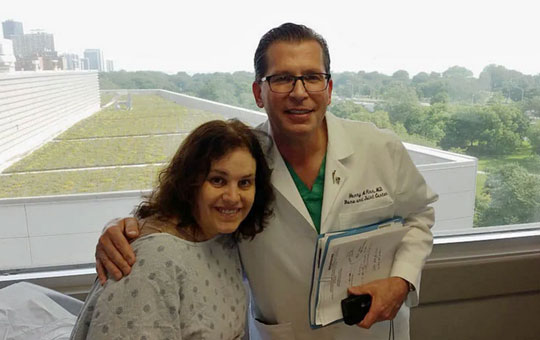“I’m a person who is not limited in what I want to do,” said Ondrea Tye, 63, a City of Los Angeles Urban Planner. But when a condition called arthrofibrosis afflicted her knee, she experienced some limitations. “My quality of life suffered. I could no longer do much of what I wanted to do – walk my dogs, ride my bike, explore wildlife photography.”
Arthrofibrosis, also known as “stiff-knee syndrome,” effects about 50,000 Americans. The condition is the result of aggressive scar tissue build-up following a total knee replacement, resulting in limited motion of the knee. Surgeons are unclear as to why it happens in some patients and not in others.
After her first joint replacement in her right knee, Tye’s arthrofibrosis got progressively worse over a seven-year period, despite physical therapy and manipulation under anesthesia.
“I read in various online knee forums about others who suffered from arthrofibrosis, and got their scars debrided; however, the tissue returns and becomes more depilating,” Tye said. “It was like mowing a lawn: It would grow back again.”
Tye saw many doctors in California who proposed cutting out the scar tissue, but she recalls them explaining no procedure or process to prevent the arthrofibrosis from returning. “I needed to find a doctor who could remove the scar tissue and prevent it from recurring,” Tye notes.

By the time she sought out medical care by Henry Finn, M.D. at the Chicago Center for Orthopedics (CCO) at Weiss Memorial Hospital, she could bend her knee only 20-degrees (normal flexion is 135 degrees). “I couldn’t stand for long periods of time. I was limping, and I used a cane to get around,” Tye said.
Due to the pain in her right arthrofibrotic knee, Tye says she favored walking on her left leg, which caused arthritis and a contracture to develop more quickly in that knee. She was then in need of another knee replacement.
Desperate to find the right surgeon to relieve her pain, through online research she discovered one of the few surgeons who performs a novel treatment to reverse the effects of arthrofibrosis: Dr. Finn, medical director of CCO at Weiss and professor of orthopedic surgery at the University of Chicago. As a world-renowned knee revisionist, he treats patients with arthrofibrosis through a 2-step process. First, there’s a low-dose radiation treatment prior to the revision surgery. “The radiation essentially prepares the body for another procedure by turning off the scar- and bone-forming cells that come with surgical trauma,” Dr. Finn explains. The previous knee replacement is then removed and revised to a rotating-hinged knee device, which allows greater freedom of motion.
“As I read about it, I thought it was a brilliant method,” Tye says, so she contacted Dr. Finn at Weiss to make an appointment, and ultimately traveled half-way across the country to undergo the approach that Dr. Finn pioneered for patients with arthrofibrosis following total knee replacement.
Tye had her arthritic knee operated on at the same time – the first time Dr. Finn performed a revision for arthrofibrosis, and simultaneously replaced the opposite osteoarthritic knee with a conventional implant. Dr. Finn was concerned because the flexion-contracture in her arthritic knee was so severe that it would have been more difficult to recover from an operation on her arthrofibrotic knee only.
“Going into surgery, Ms. Tye literally didn’t have a leg to stand on,” Dr. Finn explained. “By having both knees done simultaneously this made her a candidate for inpatient rehabilitation, which I felt was in her best interest. Despite the minimal increased risks with bilateral knee replacement, it was the most compassionate care we could give her.”Dr. Finn didn’t treat her left arthritic knee with radiation prior to surgery. “It’s my experience that arthrofibrosis can be a one-time event. People are not necessarily pre-disposed to it genetically.”
Two weeks post-surgery, Tye is feeling fine. “There was more pain with the bilateral surgery, but yes, doing both knees at once was the best in my situation.” She added the inpatient rehabilitation at Weiss made all the difference in her quick recovery.
“When I first met Ms. Tye she was depressed, anxious and frankly, looked miserable,” Dr. Finn says. “Now her pain and posture are better. She’s upbeat, happy and hopeful.” Three-weeks post-op, her flexion was at 87-degree and 94 degrees in her right and left knees, respectively. At six weeks, following outpatient physical therapy, she could bend both of her legs at 110 degrees. Now three months post-op, she has full range of motion at 135 degrees.
An active retirement is now on the horizon for this urban planner. She expects to travel the world, capturing wildlife in action on her digital camera, teaching English as a second language, and biking. “I want to stay active,” Tye smiles.
